
2012.05.30
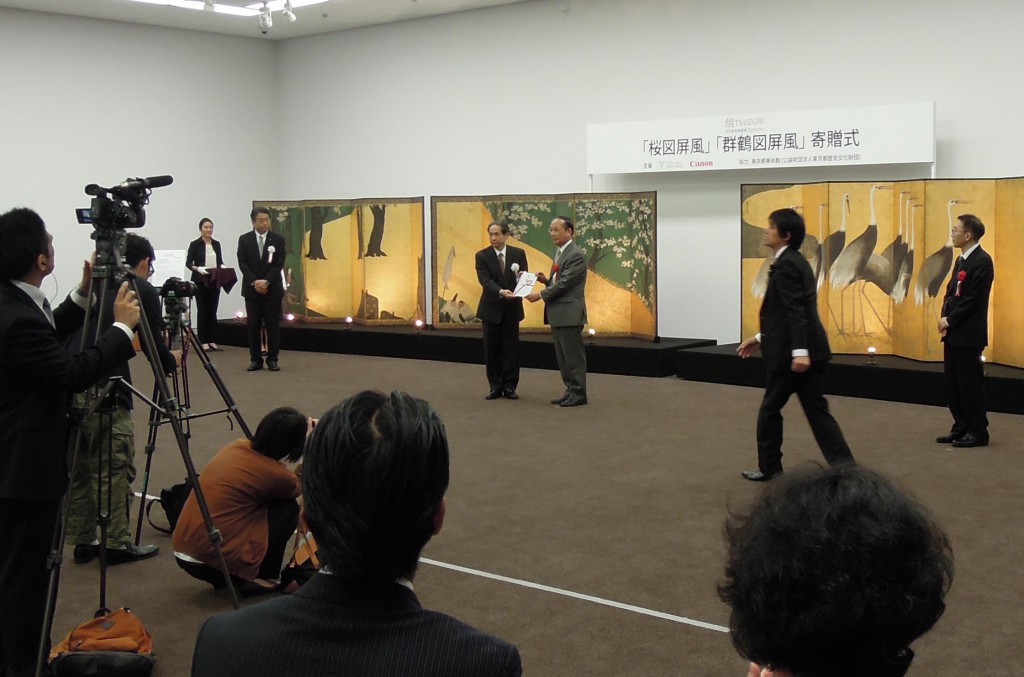
The 5th Art Donation Ceremony of the “Tsuzuri Project” (Cultural Heritage Inheritance Project) was held. The “Tsuzuri Project” is a social contribution activity that the Kyoto Culture Association and Canon Inc. promote together. This time, a pair of high-definition replicas of 6 panel folding screens was donated to the Tokyo Metropolitan Museum. They are high-definition copies of the Sakura-zu Byobu, meaning “cherry blossom design folding screen” (by Sotaro Tawaraya, one of the collection of the Freer Gallery of Art, Smithsonian Institution, Washington, DC) and Gunkaku-zu Byobu, meaning “flock of cranes design folding screen” (by Kourin Ogata, also the collection of the Freer Gallery of Art, Smithsonian Institution, Washington, DC).
The two reproduction pairs of the folding screens were closely comparable to the original and done so beautifully from the fusion of the advanced digital technology of Canon and the artisanship of Kyoto’s traditional crafts history. In the future, we plan to use the donated folding screens centering on art communication projects at places such as practical art viewing education and various workshops.
Many TOBIRA candidates (hereafter: TOBIKOs) also joined the Memorial Ceremony, and took a long and hard look at the folding screens after the Donation Ceremony. One advantage of having a reproduced copy is being able to view them this closely without the need to place them inside a glass case. While keeping the original pieces stored in an environment to prevent degradation, realistically experiencing the pieces’ appeal is the beauty of a high definition copy and the concept of the Tsuzuri Project (Cultural Heritage Inheritance Project). It is possible for people with weak vision to view the screens up close and experience the folding screen’s light in a regular daily living space. It seemed that the TOBIKOs were seriously pondering how to utilize the pair of donated screens in the future while viewing them.
In the exhibition hall, there was also an exhibit regarding the technology used in creating the high-definition copies in addition to the donated pieces. The TOBIKOs got to see a demonstration of high-resolution photography and color output technology by printing out the same exact color as the copied object using Canon’s camera and printer. The paper used for the printout was researched to make sure that the inkjet printer’s color representations will come out while still keeping the impression of the Japanese-style paper used in the folding screens. I could see their thorough dedication.
Next, there was a demonstration on how they placed real gold leaf on the picture that was printed out. Making brand new gold leaf look like it has been aged over the years is a technique that can only come from a seasoned and skilled artisan and is therefore brought out in the reproduction. It was truly a moment of collaboration between cutting-edge technology and craftsmanship that has been passed on from generation to generation.
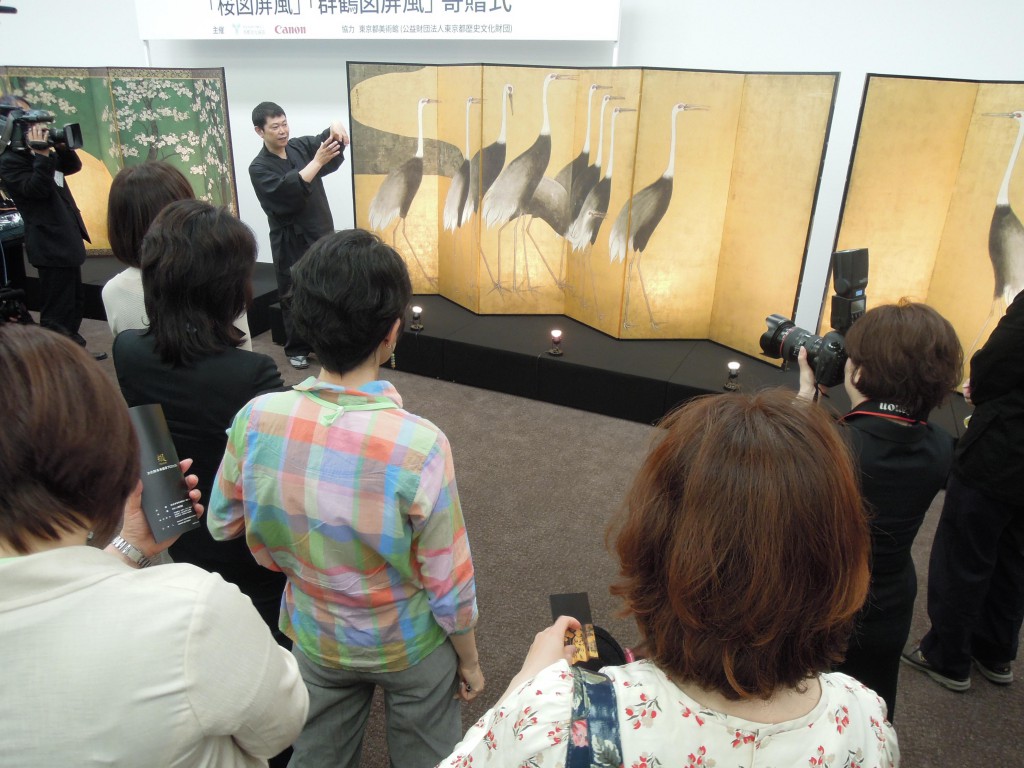
After a demonstration on the placement of the gold leaf, there was an explanation from traditional artisans of issues such as the most difficult aspects of reproducing the folding screens. I was amazed by the craftsmanship used everywhere, such as, needless to say, the scratches and changes from aging in the original, gold leaf color usage and the technique of placing the gold leaf to create shadows to give the surface pattern of the screen contours. Although there was no demonstration at the Memorial Ceremony, after the gold leaf has been inserted, the framing artist’s technique will be added to place the finished picture into the screen, and then these high-definition copies of the folding screens will finally be completed. Even though these pairs are a reproduction of the original, I felt they are amazingly valuable pieces in that so many people poured their research and hard work into it in order to complete the pieces. I am looking forward to planning programs using these screens with the TOBIKOs from now on. (Itō)
2012.05.30
記念式典には多くのとびラー候補生(以下:とびコーさん)も参加し、寄贈のセレモニーが終わると屏風をじっくりと鑑賞しました。ガラスケースなどに入れることなく、これほど間近で鑑賞できるのは、複製品ならではの利点。本物の作品は劣化を防ぐ為に環境の良いところで保存しつつも、その作品のもつ魅力をよりリアルに体感できるのがこの高精細複製品の素晴らしさであり、「綴プロジェクト」(文化財未来継承プロジェクト)のコンセプトとのこと。弱視の方が至近距離で鑑賞したり、日常の生活空間で屏風の光を体験したりも出来ます。今後、寄贈頂いた2双の屏風をどの様に活かして行くのか、とびコーさんも真剣に考えを巡らしながら鑑賞していた様子でした。
会場内では、寄贈作品の展示に加え、高精細複製品をつくる技術についての展示も行われていました。キヤノンのカメラとプリンターを使いながら、高画質の撮影と、被写体と全く同じ色でプリントアウトを行うカラー出力の技術の実演を見学させて頂きました。プリントアウトに使われる紙は、屏風に使われている和紙の印象を保ちながらも、インクジェットプリンターの色彩表現を引き出せる様に研究されたもの。徹底したこだわりが伺えます。
続いて、プリントアウトされた絵に本物の金箔を打つ実演も行われました。真新しい金箔を、経年変化で古びた風合いにみせるなど、熟練した匠だからそこの技が屏風の複製に活かされていました。まさに、最先端の技術と代々伝受け継がれた匠の技のコラボレーションの瞬間でした。
2012.05.27
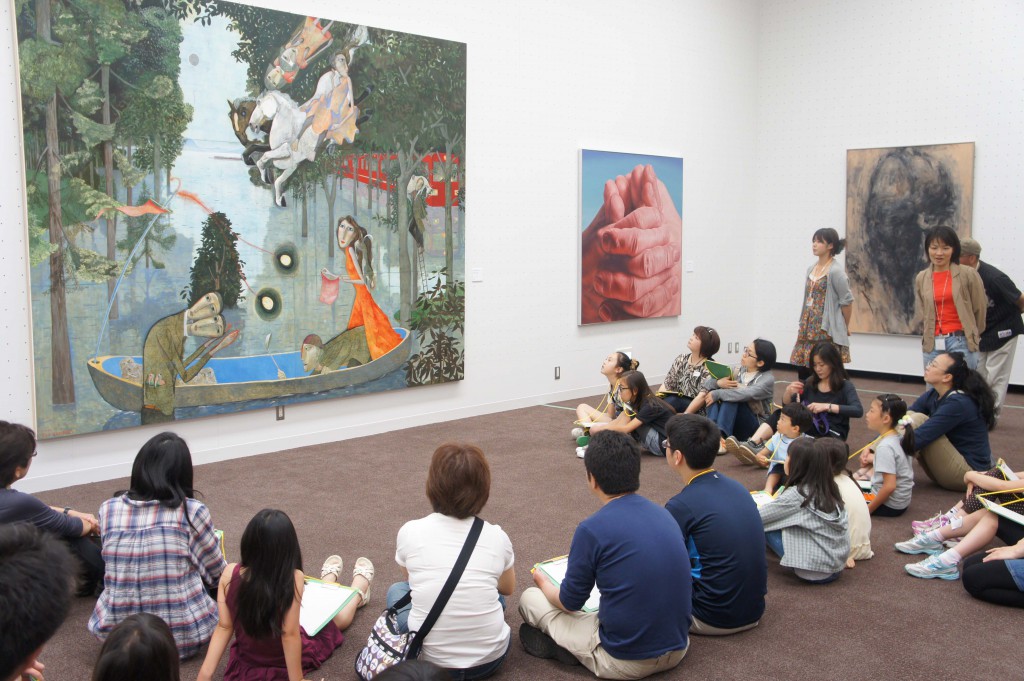
On the last day of the “Public Exhibition of Best Selection Works 2012,” based on things like the color of the paintings and sculptures exhibited, a workshop was offered to create a unique color sample book called the “Variety Color Book.” This project, offered in collaboration by the Tokyo Metropolitan Art Museum and the Bijutsu Shuppan Service Center Co., Ltd. – which runs the TOBI museum shops – was the first workshop to invite a wide range of participants since the opening of the renovated Museum. There were a total of 25 participants, both adults and children, all of whom enjoyed themselves. Of course, the TOBIRA candidates (hereafter: TOBIKOs) firmly took charge of providing support for the workshop.
When the workshop started, everyone immediately headed to the exhibition room, and under Curator Ms. Sawako Inaniwa’s facilitation, the participants viewed a single painting. With everyone talking while viewing the paintings, they were able to discover new things together: pretty colors are hidden in unexpected places and they felt the messages embedded in the colors.
Once everyone got the hang of art viewing, the TOBIKOs and participants divided themselves into small groups of approximately three people each and looked for their favorite painting. The “Public Exhibition Best Selection Works 2012” features 27 groups that are especially diligently active among numerous public organizations, and only artists from each organization that received recommendations are exhibited. This is a public organization all-star exhibition, so to speak. Various expressions like Japanese paintings, oil paintings, watercolor, crafts and sculptures filled the exhibition room.
While speaking about various things with the TOBIKO, participants picked two favorite pieces and closely viewed them. The TOBIKOs seemed to be having fun as well.
Once they found their favorite paintings, everyone gathered in the art study room and presented their favorite pieces using the evaluation card. Various paintings were lined up on a table.
After the presentations, everyone created the colors present in their favorite paintings by combining paints. They carefully mixed the colors in order to make the color close to the striking colors in the paintings. Participants made five colors from each painting. The newly-made colors were painted carefully on separate strips of paper.
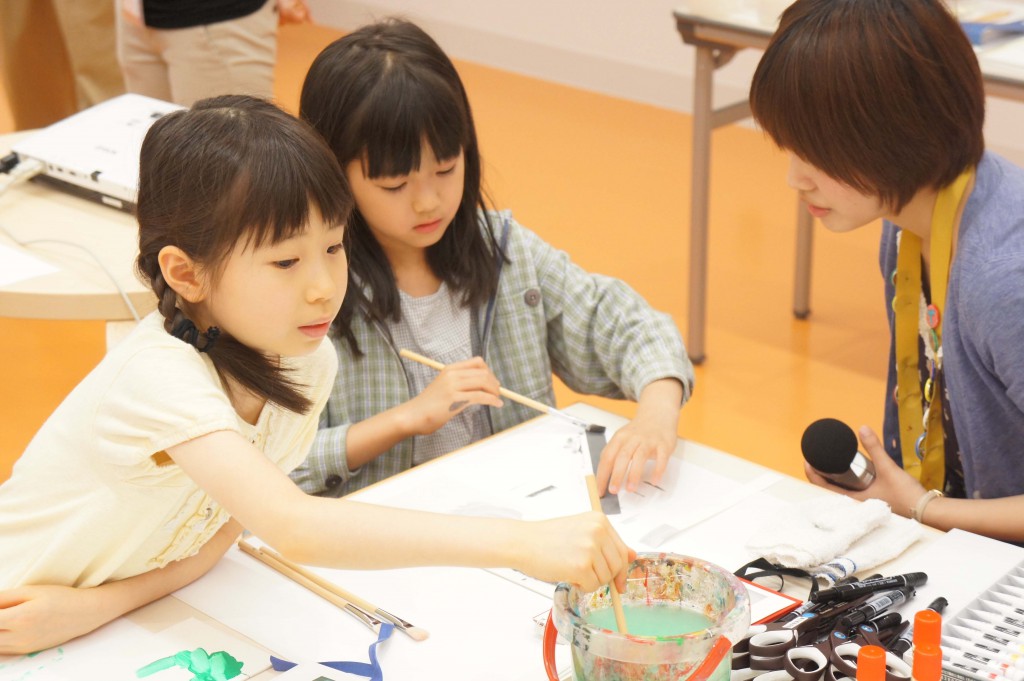
The two paintings generated a total of 10 color strips. Next, the participants cut the painted color strips with scissors and made color pieces. The sizes and shapes, etc. of the color pieces were made with the painting as a hint – A color that was used in a large area would be a large square piece, a color that was seen only as a glance would be a tiny triangle, and so on.
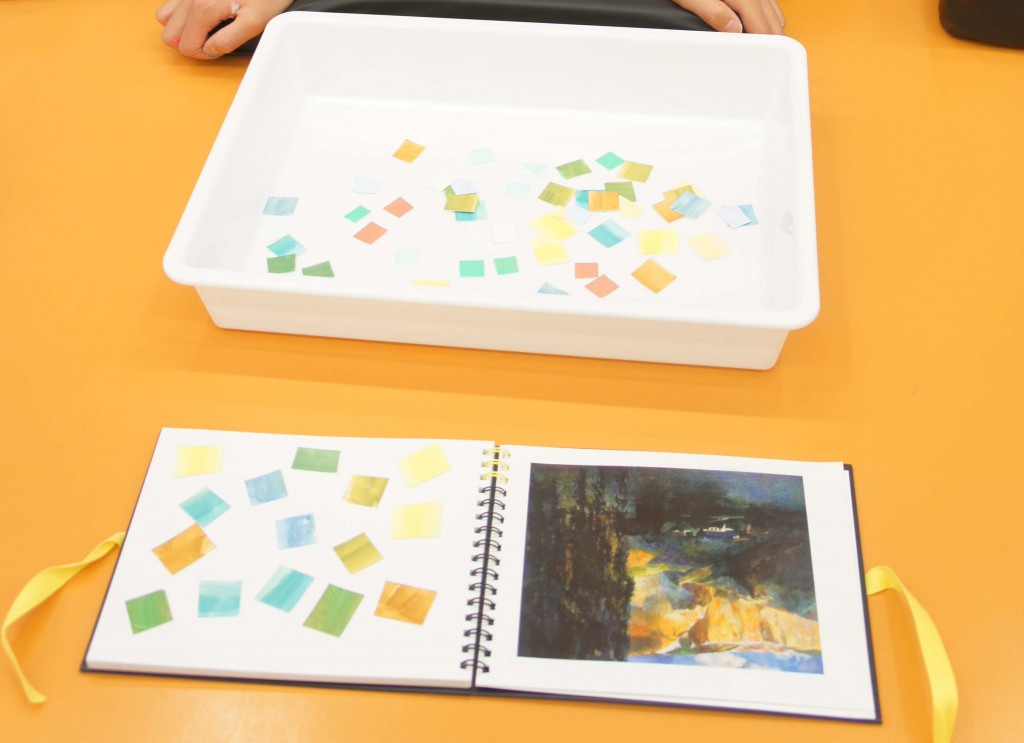
Finally, participants created a color sample book with the color pieces they had made. All of them glued a copy of their favorite painting into a sketch book and placed the color pieces created based on the painting right next to it. They re-organized the colors extracted from the original painting, and it created a different flavor. Maybe everyone felt their favorite paintings more deeply by thinking about the colors hands-on, rearranging the placement of colors and experiencing the effects adjacent colors create.
Everyone made their own color sample book. Of course the color sample books looked beautiful, but even the inside of the tray with the leftover color pieces inside looked quite pretty as well.
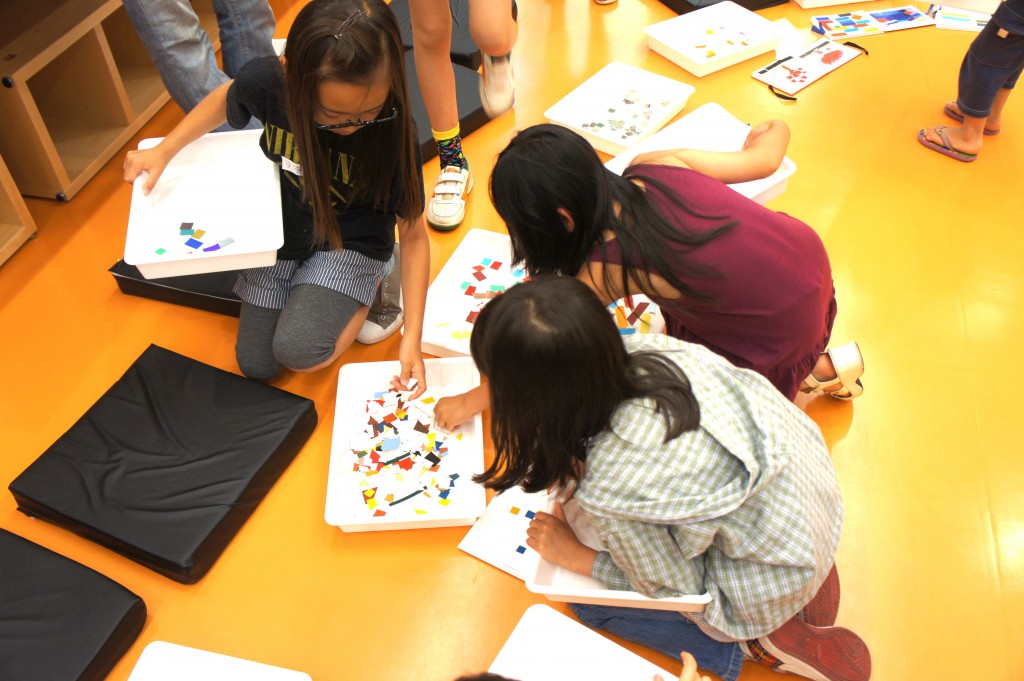
At the end, everyone exchanged the leftover color pieces, and participants took them home as a souvenir. It would be great if many people put together the color pieces taken from their favorite painting and created a different painting in a sketchbook. The paint used today was provided by Turner Colour Works Ltd. Thank you very much! (Itō)
2012.05.27
鑑賞のコツがつかめたら、とびコーさんと参加者のみなさんが3人1組ほどの小グループにわかれて、お気に入りの絵を探します。「公募展ベストセレクション美術 2012」は数ある公募団体のなかでも特に精力的に活動をしている27団体を取り上げ、かつ各団体の中で推薦を受けた作家のみが展示をしている、いわば公募団体オールスターズの展覧会。日本画、油画、水彩、工芸、彫刻と多彩な表現が展示室内にあふれています。
とびコーさんといろいろ相談をしながら、お気に入りの絵を2点決めてじっくりと鑑賞します。とびコーさんも楽しそうです。
お気に入りの絵がみつかったら、アートスタディルームに集まって、作品カードでお気に入りの絵を発表します。いろいろな絵がテーブルの上に並びました。
発表のあとは、各自お気に入りの絵の中にある色を絵の具を混ぜてつくります。その絵の中にある印象的な色に近づけるように、丁寧に色を混ぜ合わせます。1点の絵から5色の色をつくります。出来た色は1色ずつ帯状の紙に丁寧に塗ってゆきます。
いよいよ出来た色のピースを使って色見本帳をつくります。スケッチブックにお気に入りの絵を貼り、その隣に、お気に入りの絵をもとにつくった色のピースを貼ってゆきます。絵から取り出された色たちが再構成されて、また違った味わいが出ています。手を動かしながら色を考えたり、色の配置を並べ替えながら、隣り合った色と色の影響を体験したりすることで、よりお気に入りの絵を深く感じることができたのではないでしょうか。
みなさんそれぞれの色見本帳ができました。色見本帳もさることながら、あまった色のピースが入ったバットの中もなかなか奇麗です。
そこで最後は、あまった色のピースをお互いで交換し合いました。交換した色のピースはお土産としてお持ち帰り頂きました。たくさんの人がお気に入りの絵の中から取り出した色のかけらを拾い集めて、スケッチブックの上でまたちがった絵ができたら素敵ですね。今回の絵の具は、ターナー色彩(株)さまからご提供いただきました。ありがとうございました!(伊藤)
2012.05.26
前回の「とびラーのコミュニケーションデザインを考える」で、浮上した「とびら楽団」がついに活動を開始しました。呼びかけに答えてくれた方々は何と20名。すごい!サックスにコントラバス、ウクレレまでいます。第4回基礎講座のあと、初練習となりました。天気もよかったので、目の前の上野公園で演奏してきました。初見でみなさん演奏できるのが凄いと思いました。NHKみんなのうた「メトロポリタン美術館」が当面の課題曲です(笑)。何せ、都美は東京メトロポリンタンミュージアムですので。練習中に、犬を散歩していたお婆さんから声をかけられたり、考えてみれば、とびラー初の地域活動でした。アートコミュニケータに音楽は必要ですね。とびら楽団は、曲を演奏する人たちだけでなく、とびらプロジェクトに関わる皆さん全ての心を音楽で動かして行けるような、そんな楽団になればと願っております。さらに、こうしたエネルギーが美術館と地域や社会をつなぐ原動力になるのではと、すごく期待しています。(伊藤)
2012.05.26
第四回目の基礎講座は「学びの環境づくりを考える」。午前中の講師は、東京都美術館学芸員でアートコミュニケーション事業担当係長の稲庭彩和子さんと、損保ジャパン東郷青児美術館顧問の小口弘史さん。まずは、稲庭さんから、美術館に訪れる人々と作品をつなげることについて、学芸員になる前のご自身の体験談や、学芸員としてこれまで取り組まれてきたことなどをレクチャーして頂きました。美術館を単なる文化を学び知る場と捉えるのではなく、自らと対話する空間とすることの提案と実践を目的として、神奈川県立近代美術館で実施された「鑑賞鎌倉のたてる像たち」(中学生が絵画の鑑賞を通して思考を巡らす短編ドキュメンタリー)の映像などもご紹介頂きました。
引き続いて午前中の後半は、小口さんによるレクチャー。東郷青児美術館を中心とした新宿区での鑑賞教育の実践経験をもとに、美術館を利用した鑑賞教育を学校教育の中に取り入れる運用面での難しさ(授業時間内で学校と美術館とを往来することや学外授業の安全管理など)をご指摘頂きながらも、学校連携のプログラムについてとびらプロジェクトに期待する効果などをお話頂きました。また、東郷青児美術館で実施されていた対話による鑑賞教育の内容にも触れ、一般的な鑑賞方法と対話による環境方法との比較などを伺うことが出来ました。
午後の基礎講座の講師は稲庭さんと、同じく東京都美術館学芸員の武内厚子さん。早速、対話型鑑賞教育の実践に入りました。まずは、本物の作品をじっくり一人で鑑賞するところからスタートです。全員が展示室に移動して、気になった作品をじっくり鑑賞し、各々感想をメモしてゆきました。
対話による鑑賞方は、まず、各自がじっくり作品を鑑賞するところからはじまります。各自が感想をまとめたら、特にお気に入りの1点を選んでアートスタディルームに戻ります。
アートスタディルームに戻ってからは、稲庭さんの指示のもと、各自特に気になった作品について作品カードを使いながら、他のとびラー候補生と作品の感想を共有しました。
自分がその作品をどの様に感じたのか、みえたのかを説明することで、周囲の理解も深まり、これまでとは違った絵の見え方に気付くことができました。また、こうした時、作品の感想を話す側だけでなく、感想を聞く側の「きき方」がお互いの理解を深める上でとても大切になりますが、さすがとびラー候補生、2回目の基礎講座「きく力」の成果が随所に現れている様に感じました。
最後は武内さんによるVTS(ヴィジュアル・シンキング・ストラテジー)の実践。実践講座にてとびラーがマスターしなければならない対話による鑑賞方のファシリテーションです。VTSでは、作品を鑑賞する際に、美術史の知識を必要としません。その代わりに、ファシリテータが複数の鑑賞者のそれぞれ違った感想や発見をいくつも引き出しながら、作品から紡ぎだされる鑑賞者の多様な声を丁寧に整理し、重ねてゆくことによって、作品への理解を統一的なものとせずに、個々人の中で深めて行く方向へと導きます。非常にファシリテータの経験値と力量が必要となりますが、きっととびラー候補生のみなさんなら大丈夫でしょう!とびラー候補生も日々成長しています。(伊藤)
2012.05.26
The TOBIRA Band, which came up in the previous “Thinking about TOBIRA Communication Design,” has finally started, with 20 people answering the call. This is great! There is even a saxophonist, a contrabassist, and even a ukulele player. The first practice was held after the 4th Foundation Course. Since the weather was good, they performed right over in Ueno Park. I thought it was amazing that everyone could perform at sight. The NHK song “Metropolitan Art Museum” was their theme song for the meantime (laugh). At any rate, the Tokyo Metropolitan Art Museum is a Tokyo metropolitan museum. While they were practicing, an old woman walking a dog called out to them. Come to think of it, this was the TOBIRA’s first activity in the area.
Music is needed for art communication. The TOBIRA Band isn’t just a group of people performing songs. I wish for them to be a group that moves the hearts of all involved in the TOBI Gateway Project through music. Also, I really look forward to this energy being the driving force connecting the Museum to the region, society and others. (Itō)
2012.05.26
The 4th Session of the Foundation Course was called “Thinking about Creating a Learning Environment.” The morning instructors were Ms. Sawako Inaniwa, a curator and Chief for Education and Public Programs at the Tokyo Metropolitan Art Museum, and Mr. Hiroshi Oguchi, an advisor to the Seiji Togo Memorial Sompo Japan Museum of Art. At first, Ms. Inaniwa gave a lecture about connecting museum visitors with works of art, including her personal experience prior to becoming a curator and the things she had done in that role. She also introduced images and other materials from an event offered at the Museum of Modern Art, Kamakura & Hayama called “Statues of Kamakura.” (This was a short documentary in which junior high school students went through a thinking process by viewing paintings.) Its purpose was to suggest and practically apply the Museum as a space to have a conversation with oneself, rather than considering it merely a place to study and learn about culture.
The second half of the morning session was a lecture by Mr. Oguchi. Based on his hands-on experience teaching art viewing around the Seiji Togo Museum in Shinjuku Ward, he pointed out the operational difficulties of introducing art viewing education utilizing museums into school curriculum (Examples include trips between the school and museum during class time and safety management outside of the school). While he pointed out these difficulties, he talked about topics such as the results he hopes to see in the TOBI Gateway Project regarding the school collaboration program. He also touched on the content of art viewing education through conversation offered at the Seiji Togo Museum, and we got to hear comparisons between common art viewing methods and conversational environment methods.
The instructors for the afternoon session of the Foundation Course were Ms. Inaniwa and Ms. Atsuko Takeuchi, also a curator at the Tokyo Metropolitan Museum. They immediately began with the practical application of conversational art viewing education. First, they started by thoroughly observing actual art pieces on their own. Everyone moved to the exhibition room, carefully observed a piece of artwork that caught their attention, and jotted down their own thoughts.
The method of art viewing through conversation started with each individual carefully examining the art piece. When everyone had finished compiling their impressions, they each selected one favorite piece and returned to the art study room.
After returning to the art study room, under Ms. Inaniwa’s direction, they all shared their thoughts on the piece they found most intriguing with one another other using art works cards.
By explaining how they saw and felt about their chosen art pieces, the understanding of others was deepened and we were all able to discern a completely different way to see the painting. In moments like these, mutual understanding is deepened by not just the person speaking about their thoughts on the piece, but also the way of listening among the listeners who hear the thoughts. As you would expect, I felt that the outcome of the 2nd Foundation Course, “The Power of Listening,” was apparent everywhere.
Lastly came Ms. Takeuchi’s demonstration on VTS (Visual Thinking Strategy). This was a facilitation of the art viewing through conversation method that the TOBIRAs have to master for the Practical Application Course. VTS does not require any knowledge of art history when viewing the art. Instead, the facilitator carefully organizes and overlaps the viewers’ various voices that are spun off from the art pieces while bringing out such things as the multiple viewers’ various impressions and discoveries. This does not produce a single, unified understanding of the piece, but takes it to a deeper level in each person. Although a lot of experience and competence is a necessity for the facilitator, I am sure the TOBIRA candidates will do just fine! They are making progress day by day. (Itō)
2012.05.20
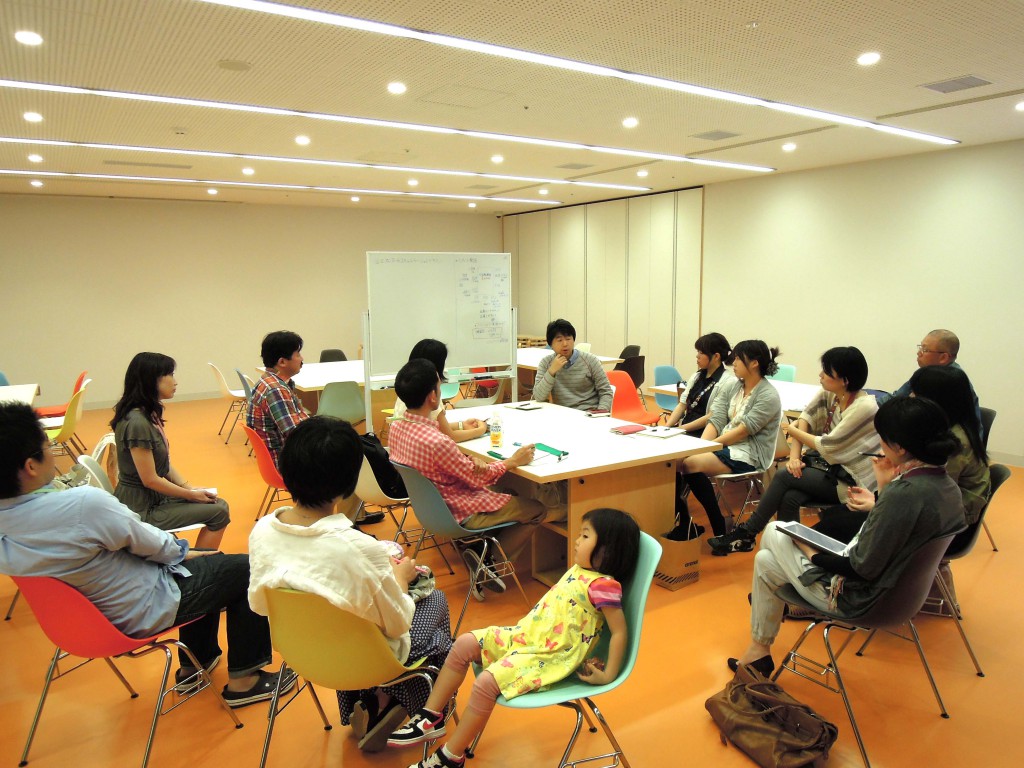
The TOBI Lab on Sunday, May 20th concerned a topic that I (Tatsuya Itō) had called for: “Thinking about TOBIRA Communication Design.” We had the meeting with themes like how we can have smoother communication between more than 100 people, including TOBIRA candidates and staff, and what we should do to make TOBI an even more stimulating place for the candidates. Although a bit presumptuous, I suggested founding a “TOBIRA Band.” I made this suggestion thinking that with this many people, there have to be some who can play instruments. We got quick approval, and the Symphony was founded at once. I hope that the TOBIRA Band will not just be a group of people performing songs, but a group that will move the hearts of everyone involved in the TOBI Gateway Project with their music. Besides that, many opinions were exchanged, from a method of information sharing through e-mail and blogs, etc., to more specific ones like “Once the Foundation Course is done, there is no place for all of the TOBIRA candidates to meet up. We would definitely like to create a place for everyone to get together on a regular basis.” Another idea was promoting analog communication by adding comments to the common topic of conversation with sticky notes on the wall of the art study room. The first half of the Foundation Course has already passed. Aside from basic knowledge for TOBIRA candidates, horizontal networking will also provide an important foundation. (Itō)
2012.05.20